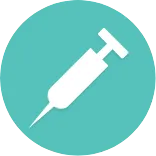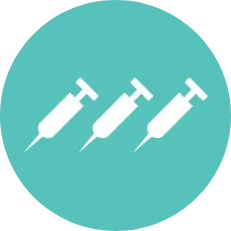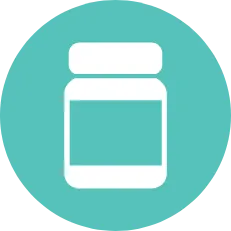INDICATION
EPCLUSA (sofosbuvir 400 mg/velpatasvir 100 mg, 200 mg/50 mg tablets; 200 mg/50 mg, 150 mg/37.5 mg oral pellets) is indicated for the treatment of patients 3 years of age and older with chronic hepatitis C virus (HCV) genotype 1-6 infection without cirrhosis or with compensated cirrhosis and in combination with ribavirin for those with decompensated cirrhosis.
Please see below for Important Safety Information for EPCLUSA.
Efficacy
CONFIDENTLY CURE YOUR CHRONIC HCV PATIENTS WITH EPCLUSA OR ITS AUTHORIZED GENERIC1
(sofosbuvir/velpatasvir)
Featured patients compensated by Gilead.
SIMPLIFY CURE RATES
ONLY EPCLUSA HAS
100%
OVERALL CURE RATE (mITT) IN PEOPLE WHO INJECT DRUGS AMONG PANGENOTYPIC REGIMENS2,3
GT 1-4 NC/CC (n=97/97;
SIMPLIFY study)
mITT = modified intent-to-treat excludes 1 reinfection and 5 patients who did not meet virologic failure criteria [SVR rate 95% CI: 96%-100%].1,3
This post-hoc mITT analysis of patients from the SIMPLIFY trial was not in the original statistical plan and should be considered descriptive only. The mITT analysis is not presented in the EPCLUSA full Prescribing Information or the SIMPLIFY publication.
94%
OVERALL CURE RATE (ITT) IN PEOPLE WHO INJECT DRUGS WITH CHRONIC HCV1
GT 1-4 NC/CC (n=97/103;
SIMPLIFY study)
SVR12 was the primary endpoint in the SIMPLIFY study (HCV RNA <LLOQ 12 weeks after treatment completion). Achieving SVR12 is considered a virologic cure.1,4
SIMPLIFY STUDY SAFETY DATA1
- The most common adverse reactions in SIMPLIFY were fatigue (18%), nausea (13%), and headache (11%)
- Adverse reactions leading to permanent discontinuation of treatment were not observed in any subjects
ONLY EPCLUSA HAS
A 100% CURE RATE (mITT) IN ALL THESE SUB-POPULATIONS (AMONG PANGENOTYPIC REGIMENS)5 :
100% CURE RATE

ANY INJECTION DRUG USE IN THE PAST 30 DAYS
(n=72/72; 95%
CI: 95%-100%)
100% CURE RATE

At least daily injection drug use in the past 30 days
(n=26/26; 95%
CI: 87%-100%)
100% CURE RATE

Current mat
(n=54/54; 95%
CI: 93%-100%)
100% CURE RATE

Alcohol use in the past 30 days
(n=60/60; 95%
CI: 94%-100%)
100% CURE RATE

Unstably housed
(n=22/22; 95%
CI: 85%-100%)
100% CURE RATEa
GENOTYPE 3
(n=57/57; 95%
CI: 94%-100%)
(n=97; SIMPLIFY study)3
a 95-97% cure rate in GT 3 patients receiving EPCLUSA (n=455/475) in the ASTRAL‑3 and POLARIS‑2 and -3 studies.1,6
SIMPLIFY STUDY INFORMATION AND LIMITATIONS1,3
- mITT = modified intent-to-treat excludes 1 reinfection and 5 patients who did not meet virologic failure criteria [SVR rate 95% CI: 96%-100%]
- Among the 6 excluded patients, 4 were on current MAT, 4 had IDU in the last 30 days, 3 had <90% adherence, 3 were GT 3, 3 were unstably housed, 2 had alcohol in the past 30 days, and 1 had daily IDU in the past 30 days
- The post-hoc mITT analysis of patients from the SIMPLIFY trial was not in the original statistical plan and should be considered descriptive only
- The mITT analysis is not presented in the EPCLUSA full Prescribing Information and the SIMPLIFY publication
SIMPLIFY ADHERENCE
In a study focused on people who injected drugs,a
CONSISTENT CURE FOR PEOPLE WITH IMPERFECT ADHERENCE2,5
ONLY EPCLUSA HAS
100%
CURE RATE (mITT) IN PEOPLE WITH IMPERFECT ADHERENCE IN A PWID-SPECIFIC STUDY2,3,5
(n=31/31; 95% CI: 89%-100%;
SIMPLIFY study)
Imperfect adherence = <90% adherence or >8 doses missed.2,7
mITT = modified intent-to-treat excludes 1 reinfection and 5 patients who did not meet virologic failure criteria [SVR rate 95% CI: 96%-100%]. Among the 6 excluded patients, 3 had <90% adherence.1,3
91%
CURE RATE (ITT) IN PEOPLE WITH IMPERFECT ADHERENCE IN A PWID-SPECIFIC STUDY1,2
(n=31/34; SIMPLIFY study)
Imperfect adherence = <90% adherence or >8 doses missed.2,7
SVR12 (cure) = HCV RNA <LLOQ 12 weeks after treatment completion.4
Overall median adherence: 94% (IQR 88-98).2
a In SIMPLIFY, “people who inject drugs” was defined as those who had injected drugs within the 6 months prior to study initiation.1
SIMPLIFY STUDY INFORMATION AND LIMITATIONS2
- Patients in SIMPLIFY were instructed to use EPCLUSA once daily for 12 weeks as recommended in the EPCLUSA full Prescribing Information
- Adherence was assessed by dividing the number of total doses received during therapy by the total expected number (84) of doses
- Adherence may have been improved by weekly clinic visits and electronic blister packs, which patients were incentivized to return. Adherence was assumed when a blister pack was damaged in a way that prevented scanning, but no pills were returned
- The post-hoc mITT analysis of patients from the SIMPLIFY trial was not in the original statistical plan and should be considered descriptive only
- The mITT analysis and SIMPLIFY adherence data are not presented in the EPCLUSA full Prescribing Information. The mITT analysis is not presented in the SIMPLIFY publication
ASTRAL PIVOTAL STUDIES
HIGH CURE RATES ACROSS PIVOTAL AND REAL-WORLD STUDIES
IN PIVOTAL CLINICAL TRIALS
98%
OVERALL CURE RATE1 IN GT 1-6 TN/TE NC/CC ADULT PATIENTS
(n=1015/1035;
ASTRAL-1, -2, -3 studies)
SVR12 was the primary endpoint in EPCLUSA clinical trials and was defined as HCV RNA <15 IU/mL at 12 weeks after the end of treatment. Achieving SVR12 is considered a virologic cure.1,4
REAL-WORLD INTEGRATED ANALYSIS
99%
OVERALL CURE RATE8 IN EFFECTIVENESS POPULATION IN GT 1-6 TN/TE NC/CC PATIENTS
(n=5141/5196; pooled analysis of 12 clinical cohorts and studies in Canada, Europe, and the USA, PP)
Cure rate for the whole population was 93% (n=5141/5552, ITT).8
Largest real-world analysis of DAA HCV regimens8
- Patients who did not achieve SVR12/24 due to non-virological (n=332) or unknown (n=24) reasons were excluded from the effectiveness population8
- Patients achieved high cure rates across diverse subgroups, including those with GT 3 (n=1649/1677) and CCa (n=1055/1078)8
- The primary outcome was SVR12/24 (HCV RNA <LLOQ 12 or 24 weeks after treatment completion), which was calculated in the overall effectiveness populations and stratified by fibrosis stage, previous or current intravenous drug use, PPI use at baseline, and treatment history8
The Real-World Integrated Analysis is not presented in the EPCLUSA (sofosbuvir/velpatasvir) full Prescribing Information.
Real-world data are observational in nature and are not based on controlled clinical studies. Results from the Real-World Integrated Analysis may differ from those observed in clinical practice. The Real-World Integrated Analysis was supported by Gilead Sciences, Inc.
a CC patients had a higher risk of not achieving a cure.
TRIAL SAFETY DATA
- Adverse reactions reported in ≥5% of subjects in ASTRAL-1 study: headache (22%), fatigue (15%), nausea (9%), asthenia (5%), and insomnia (5%)1
- The adverse reactions observed in subjects treated with EPCLUSA in ASTRAL-2 and ASTRAL-3 were consistent with those observed in ASTRAL-11
- Irritability was also observed in ≥5% of subjects treated with EPCLUSA in ASTRAL-39
- Influenza-like illness was also observed in ≥5% of subjects treated with EPCLUSA in the Real-World Integrated Analysis9,b
b Derived from the HCV-TARGET, HepaC, HELIOS, and Mangia cohorts. Adverse reaction data were not recorded in other cohorts.9
CURE RATES BY GENOTYPE AND FIBROSIS SCORE
A pangenotypic and panfibrotic treatment with consistent outcomes10
Cure rates from ASTRAL-1, -2, and -3 and POLARIS-2 and -3 studies
| Genotype | F0-F2 | F3 | F4 (CC) |
|---|---|---|---|
| GT 1-6 |
99%
(n=871/874) |
99%
(n=232/234) |
97%
(n=431/443) |
| GT 1 |
100%
(n=303/303) |
99%
(n=91/92) |
98%
(n=152/155) |
| GT 2 |
100%
(n=195/195) |
100%
(n=34/34) |
100%
(n=58/58) |
| GT 3 |
99%
(n=218/221) |
100%
(n=76/76) |
94%
(n=154/163) |
| GT 4-6 |
100%
(n=155/155) |
97%
(n=31/32) |
100%
(n=67/67) |
Cure rates (SVR12) derived from a completer efficacy analysis of the ASTRAL-1, -2, and -3 and POLARIS-2 and -3 studies, which included all patients who were randomized, completed the assigned study treatment, and had HCV RNA data observed at post-treatment Week 12 or thereafter. Individual fibrosis stage efficacy is not presented in the EPCLUSA full Prescribing Information.
END-STAGE RENAL DISEASE
HIGH CURE RATES IN HCV PATIENTS WITH END-STAGE RENAL DISEASE (ESRD) REQUIRING DIALYSIS1
95%
CURE RATE1 IN GT 1, 2, 3, 4, AND 6 NC/CC ADULT PATIENTS WITH HCV AND ESRD REQUIRING DIALYSIS
(n=56/59; Trial 4062)
EPCLUSA (sofosbuvir/velpatasvir) can be used with no dosage adjustment in HCV patients with any stage of renal impairment, including those requiring dialysis.
No safety data are available in subjects with both decompensated cirrhosis and severe renal impairment, including ESRD requiring dialysis. Additionally, no safety data are available in pediatric patients with renal impairment.
TRIAL SAFETY DATA
- The most common adverse reaction in adults with HCV and ESRD requiring dialysis (Trial 4062) was nausea (7%)
PROTON-PUMP INHIBITOR ANALYSIS
ALTHOUGH USE WITH PPIs IS NOT RECOMMENDED, EPCLUSA CAN BE USED WITH OMEPRAZOLE WHEN MEDICALLY NECESARY1
Consistent outcomes with or without PPIs1,11
In a retrospective analysis of 12 EPCLUSA Phase 2 and 3 trials in adults:
97%
CURE RATE11 WITH A PPI
(n=84/87)
97%
CURE RATE11 WITHOUT A PPI
(n=2445/2517)
- Results from the PPI analysis are not presented in the EPCLUSA (sofosbuvir/velpatasvir) full Prescribing Information
- If medically necessary, EPCLUSA should be administered with food and taken 4 hours before omeprazole 20 mg1
TRIAL SAFETY DATA11
- Treatment-emergent AEs were reported in 78% (n=68/87) of patients with PPI use vs 66% (n=1662/2517) without PPI use; grade 3 or 4 treatment-emergent AEs were present in 8% (n=7/87) of patients with PPI use vs 2% (n=58/2517) without PPI use
- SAEs were reported in 11% (n=10/87) of patients with PPI use vs 2% (n=45/2517) without PPI use; treatment-related SAEs were present in 0% of patients regardless of PPI use
1% of patients taking a PPI discontinued HCV treatment due to an AE11
Cure = sustained virologic response (SVR12; HCV RNA <LLOQ 12 weeks after treatment completion).4